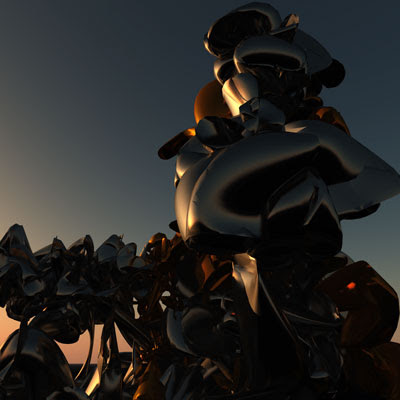Marjan Colletti, 2008.
Text-only version published in:
Nordic Talking. 4 1/2 Years in Studio with Kjetil Thorsen, Springer WienNewYork, 2009; and in
OS1: LSBU Lecture Series 2007/08, London South Bank University UK, 2008.
Within a digital architectural debate, I consider the Baroque to be remarkably contemporary because it discovered and also shattered a plethora of binary conditions, boundaries and frames that provide an analogy to today’s actuality-digitality feedback system: it re-addresses the complete independence of façade (expression, reception, materiality) and interior (effect, action, space), the separation of below (matter, function) and above (manner, vision), of tectonics and textures, of movement and stasis, of knotting and folding, of light and shadow, of thick and thin, of topologies (multiplicities of geometry and methods) and infinity (convolutions and illusion), of fixedness (carnosity, corposity of matter) and festiveness (celebration of space), and of being (manifestation) and bogus (magic). In fact, as Gilles Deleuze writes in The Fold, the Baroque ‘represents the ultimate attempt to reconstitute a classical reason by dividing divergences into as many worlds as possible, and by making from incompossibilities as many possible borders between worlds’ [1]. Influenced by the virtuality of the cosmos, as much as the Vienna Secession by the unconscious, the Baroque dichotomy of rational (Descartes, Leibniz, Spinoza, Galileo, Kepler) and empirical thinking, as well as the morphing of classical architectural semantics into playful theatrical staging provides, I believe, an adequate analogy for re-interpreting contemporary digital architecture.
Yet the Baroque is also scandalous, because on the other hand it contrasted, in its harmony and fusion of the arts and the sciences, the structural ‘truthful’ efficiency of the Gothic, which nowadays is experiencing a revival under the premise of the parametric approach, of virtual scripts, and formal organicism (understood as evolutionary mimicry). Against such trends, the concepts of CyberBaroque and of DigiTales entail an organic spatial and a strategic vision that includes materiality, atmospherics, and use in conjunction with the designer’s technological and poetic awareness. Criticising objectivity as invariance, evolution as method, users as observers, it could be argued that it is the challenge of this generation of creative thinkers (whatever the discipline) to fully engage with the actuality – rather than the virtuality – of computer-aided architectural design (CAD). That means that after the initial period of definition and discovery of disembodied virtual realities, data-scapes and cyber-realities, the endeavour now is to establish a debate in which experimentation, technology and progress do not exclude the actuality of emotions, traditions and identity.
The CyberBaroque is at hand because once again it convolutes (i.e. synthesises, overlaps and blurs) the dichotomy of rational and empirical thinking, as well as the morphing of classical-digital architectural semantics into playful theatrical tectonics and typologies. In fact, the most contemporary manifestation of digital architecture achieves the synthesis of poetic expression and intuitive knowledge, of culture and tradition as well as industry and progress. In its virtuosity, the digital CyberBaroque avant-garde reconciles the actual with the virtual/digital, the technological with the poetic/intuitive, the mathematical with the artistic/blissful, the gestural with the figural/figurative, the intermediary with the medium/mediated, and the symbolic with the social/reflexive.
Such approach favours the formulation of DigiTales - digital narratives about the strange, other and alien as well as the familiar, intimate and contextualised - that discern (actually reveal) a whole series of events and haecceities within digitality beyond the usual aspects of techniques, technologies and technics [2]. Both the CyberBaroque and DigiTales involve and invoke a plethora of arguments on the performance (understood both as task and as staging) of poetics in digital architecture. Under these circumstances, what is at hand is an alternative to the understanding and the production of truly contemporary, innovative and progressive digital architecture. Does not the convoluted nature of the subject matter go beyond the functions of complexity and intricacy? Does it not invoke something ranking above beauty, elegance and smartness? Does it not evoke the sublime, the blissful and the mysterious…?
Beyond the already established functional, structural and technological endeavour, the contemporary digital zeitgeist reflects on experimental aesthetics involving speculative spatial, atmospheric and cognitive phenomena and conditions towards the hybridisation of the programmatic and the phenomenological. Beyond interdisciplinary – unavoidable in a contemporary understanding of the discipline - the goal is to invoke the synthesis of authority and authorship, of structural functional and stylistic formal preoccupations, of manufacturing manifestos and morphogenetic methods. We are soon approaching this next stage of development. By challenging the dichotomy of style/structure, properties/parameters, (digital) architecture now involves and invokes a plethora of arguments on: performance (understood as task and as staging), (re)production, (re)presentation, surreality, simulation, theatricality, agency, otherness, ornamentation, projection, mimesis, automatism, reflection and bliss. Digital architecture is here understood in its intrinsic capacities to perform intellectual tasks beyond evolutional, algorithmic, self-reproducing genetic computational processes instigating debate within a wider social, cultural and historic context. Both in text and image, the vocabulary of architectural design is broadened beyond common standards, flirting with the extravagance and richness of the CyberBaroque: lavish, sexy, sophisticated and most of all, avant-garde.
[1] Gilles Deleuze, The Fold: Leibniz and the Baroque, trans. Tom Conley (Minneapolis: University of Minnesota Press, 1993) p 81.
[2] Techniques are here understood as process and method, technologies as scientific knowledge and applications, and technics as skills and functions.
[Images: Marjan Colletti]





























































